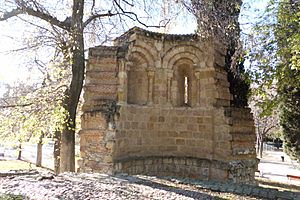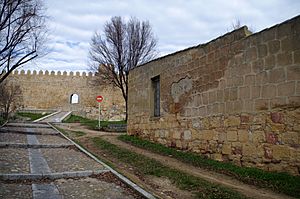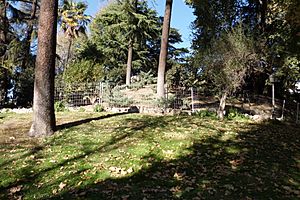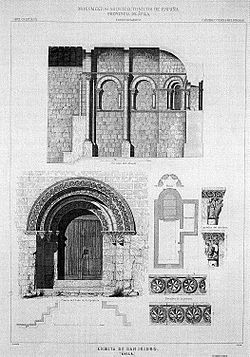Ermita de San Pelayo y San Isidoro facts for kids
The Ermita de San Pelayo y San Isidoro is the Spanish name for the Hermitage of Saint Pelagius and Saint Isidore. It is a ruined church built in the Romanesque style, a type of architecture from the Middle Ages known for its thick walls and round arches.
The church was first built in the city of Ávila, Spain. It stood just outside the famous city walls. Today, only the ruins of this ancient church are left. They were moved from Ávila and rebuilt in the Buen Retiro Park in the center of Madrid, Spain's capital city.
Contents
History of the Church
The church was first built to honor Saint Pelagius, a young martyr from Córdoba. A document from the year 1250 mentions the church. There is also a stone carving from 1270 that might mark a second ceremony for the church. Historians think this is when the church was rededicated to Saint Isidore.
For many centuries, not much was written about this small church. We only learned more about its story in the 19th century when old books from a church in Ávila were found. It is also believed that the holy relics of Saint Isidore were kept here before they were moved to the city of León in 1062.
Moving a Church Stone by Stone
In the 1800s, the church was owned by a group of farm workers. By 1854, the building was in very bad shape. The city council ordered the owners to tear it down. The owners offered to give the church to the city, but the city said no.
The church was set to be demolished, but nothing happened for many years. Then, in 1876, the Spanish government began taking ownership of many properties, an event known as the Spanish confiscation. The church was finally taken down in 1877.
Instead of being destroyed, its stones were sold. A man from Ávila bought most of them. The rest of the stones and carved pieces were bought by Emiliano Rotondo Nicolau, an engineer from Madrid who loved archaeology. He sold the ruins to a history organization in 1893. The plan was to rebuild the church in the gardens of an archaeology museum in Madrid. It was even going to be used as a chapel for special church services.
A New Home in the Park
The plan to rebuild the church didn't happen right away. In 1897, a government leader named Antonio Cánovas del Castillo became interested in the project. He had the ruins moved to their final home in the Buen Retiro Park. The architect Ricardo Velázquez Bosco was in charge of placing the ruins in a beautiful spot surrounded by old trees.
For a long time, the ruins were neglected and almost forgotten. But in the early 2000s, the city of Madrid decided to restore the site. Workers gathered the scattered stones, pillars, and carvings to bring back some of the church's old glory.
What the Church Looked Like
The hermitage was built from rectangular blocks of limestone called ashlars. It was a simple building with one main hall, called a nave, which had a wooden roof. The end of the church had a semi-circular area called an apse, which was a common feature in Romanesque churches.
The church had two doors. The remains of one door show that it had three rounded arches, known as archivolts. These arches were decorated with carved roses. The pillars holding up the arches had carvings of animals and plants, like acanthus leaves.
The apse had three small, rounded windows. These windows were narrow on the outside but wider on the inside. The arches above the windows were supported by pillars with carvings of leaves and birds. The style of the carvings is very similar to other famous Romanesque churches in Ávila, which helps experts date the church to the mid-1100s.
See also
 In Spanish: Ermita de San Pelayo y San Isidoro para niños
In Spanish: Ermita de San Pelayo y San Isidoro para niños
- Romanesque architecture in Spain









